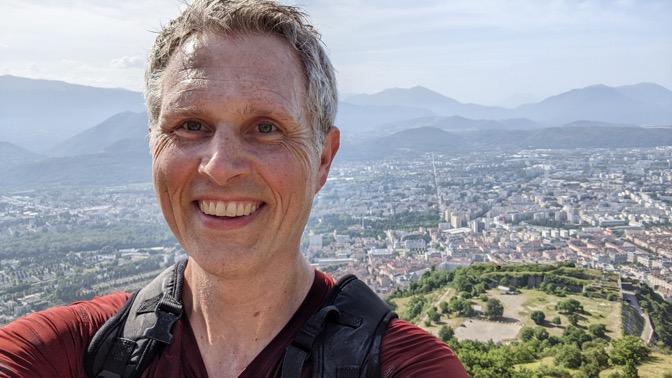
4 minute read
Tim Jackson’s Sabbatical in France
Tim Jackson’s French Connection
A sabbatical in France leads to new insights into Co and Mn reactivity
Advertisement

Collaborative projects combine the diverse expertise from multiple labs to tackle grand research challenges. In January of 2020, Prof. Tim Jackson and his lab started a collaborative project with Dr. Carole Duboc and Dr. Marcello Gennari at the Université Grenoble Alpes. This collaboration combined the Jackson Lab’s expertise in kinetic methods, spectroscopy, and electronic structure computations with expertise in synthesis and electrocatalysis from the Duboc and Gennari Labs. The goal of the project was to develop new catalysts for oxygen reduction that use earth-abundant metals such as Fe, Mn, and Co. Such catalysts could serve as relatively inexpensive materials in fuel cells. Moreover, detailed studies of homogeneous catalysts can provide insight into the complicated steps involved in oxygen reduction, a multi-electron, multi-proton process, which could aid in the design of more efficient catalysts. While this international collaboration was off to a great start, something happened in March of 2020 that considerably slowed down the research efforts! Labs were closed (for a time). The faculty involved in this project had to learn how to teach and mentor students online. There were significant disruptions in obtaining supplies needed for this work. These and other challenges might be enough to destroy any collaboration! To reboot this promising project, Tim spent a portion of his sabbatical in spring of 2022 as a Visiting Professor at the Université Grenoble Alpes. Grenoble, often called the capital of the Alps,
is a city of about 700,000 situated in the southeast of France. In addition to containing the Université Grenoble Alpes (one of the top Universities in France for STEM), Grenoble is also home to one of the largest labs of the French Alternative Energies and Atomic Energy Commission (CEA). Tim spent most of his sabbatical working in the Department of Molecular Chemistry with Dr. Duboc, Dr. Gennari, and their research groups. This team revisited some of the early observations made in 2020. From this new work, it was determined that a pair of structurally similar manganese and cobalt complexes have different electrochemical reactivities with oxygen. While the manganese complex only reduces oxygen by two electrons, generating hydrogen peroxide, the cobalt complex performs the complete, four-electron reduction of oxygen to water. Tim’s lab at KU is currently performing electronic structure computations to understand the reason for this difference in reactivity. In addition to these research activities, Tim gave presentations about his research at KU to faculty and students in France. He was the plenary speaker at a half-day symposium, and he gave an invited talk at the CEA Grenoble Center. In addition to being a science and technology hub, Grenoble is also known for its food, which is heavily influenced by Italian cuisine (Tim stayed on a street with no fewer than ten pizzerias!). As the capital of the Alps, Grenoble also boasts a plethora of outdoor activities. The weekends and French holidays presented Tim with opportunities for long hikes and bike rides. Sabbaticals come only once every seven years, so it’s wise to make the most of them!

Center for Molecular Analysis of Disease Pathways
The COBRE Center for Molecular Analysis of Disease Pathways (CMADP) at KU has been awarded a third and final 5-year, $5.7 million federal grant to sustain the collaborative, multidisciplinary research environment and infrastructure at KU through its research core laboratories and pilot project programs for faculty investigators. Led by director Susan Lunte, CMADP mentors earlier-career faculty researchers and provides stateof-the-art technologies through its three core labs. Its goal is to create enabling technologies, new techniques and methods that allow researchers to study diseases in novel ways and develop new therapeutics to a range of illnesses including heart and lung diseases, cancers, and neurological diseases. CMADP’s three core lab facilities are the KU (Ralph N. Adams) Nanofabrication Facility, Synthetic Chemical Biology
Core and Genome Sequencing Core. Since CMADP’s in-

NIH Center of Biomedical Research Excellence ception in 2012, these facilities have supported over 600 researchers and have been cited in more than 200 publications authored by CMADP core lab users. While there are no fourth phases in the COBRE grant system, CMADP plans to use the final round of funding to ensure each core lab remains self-sustaining through expanding their user bases. In the decade since receiving the Phase 1 COBRE award, 24 junior faculty researchers supported by CMADP have brought in over $40.5 million in external funding to KU. Thus far, CMADP has provided research/pilot project awards and contributions to new hire start-up packages for 7 KU Chemistry faculty members, including Meredith Hartley, Mike Johnson, Aaron Teator and Rebecca Whelan.










